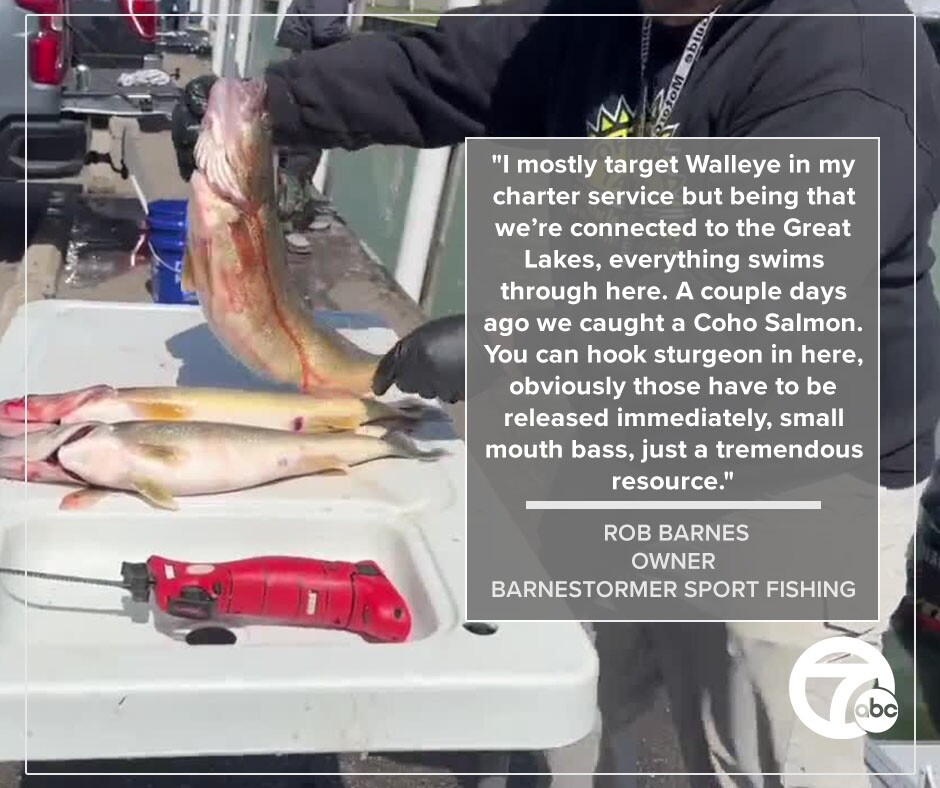DETROIT (WXYZ) — For fishermen on the Detroit River, having a hook and rod in hand is like second nature.

"We’ve got a mixture of female walleye here. These are about 25 to 26 inches, great eating fish and we got some smaller eating fish as well," said Rob Barnes as he filleted a bucket of walleye from Tuesday's catch. "I’m taking the fillets off. I remove the ribs and then the next part is I take the fillets off the skin."
Rob Barnes is the owner of Barnestormer Sport Fishing in Detroit. He says he’s been jigging for Walleye since he was 4 years old.

"I mostly target Walleye in my charter service but being that we’re connected to the Great Lakes, everything swims through here. A couple days ago we caught a Coho Salmon. You can hook sturgeon in here, obviously those have to be released immediately, small mouth bass, just a tremendous resource," said Barnes of the Detroit River.
Anglers say April and May are some of the best months to catch Walleye.

"It’s unbelievable. We have one of the most fertile fisheries in the world. The Lake Erie Walleye stock is at almost record high right now. It’s just absolutely awesome fishing. We have a huge push coming up Detroit River and just overall we’re super blessed," said Spencer Berman.
Berman is the owner of Spencer's Angling Adventures in Harrison Township. The veteran fisher says during the spring he typically takes charter guests out to fish twice a day. Tuesday, he and three guests were able to catch 24 Walleye near Sinbad's restaurant and Marina.

"Right now, there’s a lot of really big fish in the river this early in the run, so you’re trying to get trophy fish, wall hangers so to speak, and then you’re allowed 6 (fish) a day," said Berman.
Berman says although Michigan waterways are mostly safe, he’s always cognizant of the dangers that remain below the surface including forever chemicals like PFAS, PFOS and mercury levels which can be picked up by fish.
"It’s definitely something that’s in the back of your mind but we’re very lucky our water ways are very, very clean," said Berman. "We have such fast moving currents, it doesn’t tend to have as much of a buildup of mercury levels as some of the other places that have a lot more mud and muck."
The Michigan Department of Health and Human Services (MDHHS) releases an Eat Safe Fish Guide annually after testing multiple fish species in various bodies of water. The guide identifies chemicals found in different species and the potential dangers they pose to people who consume the fish.
Scientists with MDHHS say they test the filet of the fish, which is the most commonly eaten part, for things like PFAS, PFOS, dioxins, PCBs and mercury.

"Alot of our guidelines are based on mercury. Others are based on historical contaminants, 'legacy contaminants' we call them. They’re a result of industry pollution," said Brandon Reid with MDHHS.
Reid is a toxicologist who runs the state health department's Eat Safe Fish program. He says recently the department put out an advisory after discovering unsafe levels of forever chemicals in Rainbow Smelt, which anglers often catch by the bucket and carp, which people are currently advised not to eat at all from some water sources.
The state health department says ingesting even small amounts of mercury, PFOS or PFAS has been linked to thyroid hormone imbalance, neurological effects, cancer among other illness and disease.

"Up until PFOS, it was pretty easy for us. We could usually tell fish that were bottom feeders, that feed on the bottoms of lakes and rivers near the sediment, so your carp, catfish, tend to get more chemicals because that’s where they store up," said Reid. "With PFOS, unfortunately, that’s kind of breaking all of the rules that we thought were pretty standard for these chemicals. We’ve found PFOS at higher levels in smaller fish. We’ve issued a couple guidelines for smelt which are really small fish."
The state health department says they're now working to update their annual fish consumption guidelines. In the past, MDHHS has advised anglers not to eat fish like carp from specific water sources. Other fish like catfish, they recommended people only eat limited portions. As toxicologists work to evaluate the current state of marine life and water quality, they say they could be suggesting more restrictive portions for other fish species too.

"Fish can have many great health benefits. When they’re caught locally, they can provide a cheap protein source for people but it is important to balance those health benefits with the risks that can happen if the fish have more chemicals," said Reid. "Our guidelines are just that. They are guidelines. They’re not regulatory. Everyone can make the decision for themselves about how much and which fish to eat."
MDHHS plans to have an updated guideline on fish consumption this coming spring.





